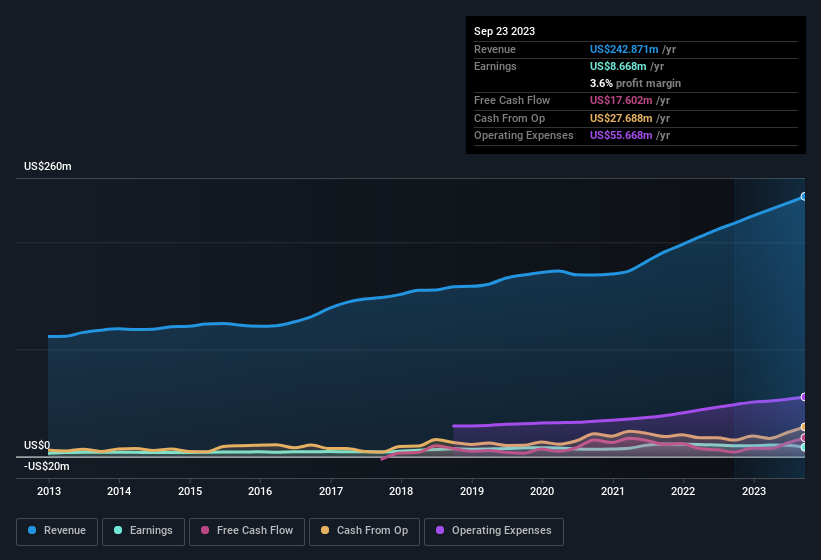- United States
- /
- Trade Distributors
- /
- NasdaqGM:TRNS
Transcat's (NASDAQ:TRNS) Problems Go Beyond Weak Profit
The latest earnings report from Transcat, Inc. (NASDAQ:TRNS ) disappointed investors. We did some digging and believe that things are better than they seem due to some encouraging factors.
Check out our latest analysis for Transcat

One essential aspect of assessing earnings quality is to look at how much a company is diluting shareholders. Transcat expanded the number of shares on issue by 17% over the last year. As a result, its net income is now split between a greater number of shares. To celebrate net income while ignoring dilution is like rejoicing because you have a single slice of a larger pizza, but ignoring the fact that the pizza is now cut into many more slices. You can see a chart of Transcat's EPS by clicking here.
How Is Dilution Impacting Transcat's Earnings Per Share (EPS)?
Transcat has improved its profit over the last three years, with an annualized gain of 27% in that time. Net income was down 14% over the last twelve months. But the EPS result was even worse, with the company recording a decline of 16%. Therefore, the dilution is having a noteworthy influence on shareholder returns.
If Transcat's EPS can grow over time then that drastically improves the chances of the share price moving in the same direction. But on the other hand, we'd be far less excited to learn profit (but not EPS) was improving. For that reason, you could say that EPS is more important that net income in the long run, assuming the goal is to assess whether a company's share price might grow.
That might leave you wondering what analysts are forecasting in terms of future profitability. Luckily, you can click here to see an interactive graph depicting future profitability, based on their estimates.
How Do Unusual Items Influence Profit?
On top of the dilution, we should also consider the US$3.4m impact of unusual items in the last year, which had the effect of suppressing profit. It's never great to see unusual items costing the company profits, but on the upside, things might improve sooner rather than later. We looked at thousands of listed companies and found that unusual items are very often one-off in nature. And, after all, that's exactly what the accounting terminology implies. Assuming those unusual expenses don't come up again, we'd therefore expect Transcat to produce a higher profit next year, all else being equal.
Our Take On Transcat's Profit Performance
Transcat suffered from unusual items which depressed its profit in its last report; if that is not repeated then profit should be higher, all else being equal. But on the other hand, the company issued more shares, so without buying more shares each shareholder will end up with a smaller part of the profit. Based on these factors, it's hard to tell if Transcat's profits are a reasonable reflection of its underlying profitability. So if you'd like to dive deeper into this stock, it's crucial to consider any risks it's facing. For example, we've discovered 3 warning signs that you should run your eye over to get a better picture of Transcat.
In this article we've looked at a number of factors that can impair the utility of profit numbers, as a guide to a business. But there are plenty of other ways to inform your opinion of a company. Some people consider a high return on equity to be a good sign of a quality business. So you may wish to see this free collection of companies boasting high return on equity, or this list of stocks that insiders are buying.
Valuation is complex, but we're here to simplify it.
Discover if Transcat might be undervalued or overvalued with our detailed analysis, featuring fair value estimates, potential risks, dividends, insider trades, and its financial condition.
Access Free AnalysisHave feedback on this article? Concerned about the content? Get in touch with us directly. Alternatively, email editorial-team (at) simplywallst.com.
This article by Simply Wall St is general in nature. We provide commentary based on historical data and analyst forecasts only using an unbiased methodology and our articles are not intended to be financial advice. It does not constitute a recommendation to buy or sell any stock, and does not take account of your objectives, or your financial situation. We aim to bring you long-term focused analysis driven by fundamental data. Note that our analysis may not factor in the latest price-sensitive company announcements or qualitative material. Simply Wall St has no position in any stocks mentioned.
About NasdaqGM:TRNS
Transcat
Provides calibration and laboratory instrument services in the United States, Canada, and internationally.
Adequate balance sheet with limited growth.
Similar Companies
Market Insights
Community Narratives




